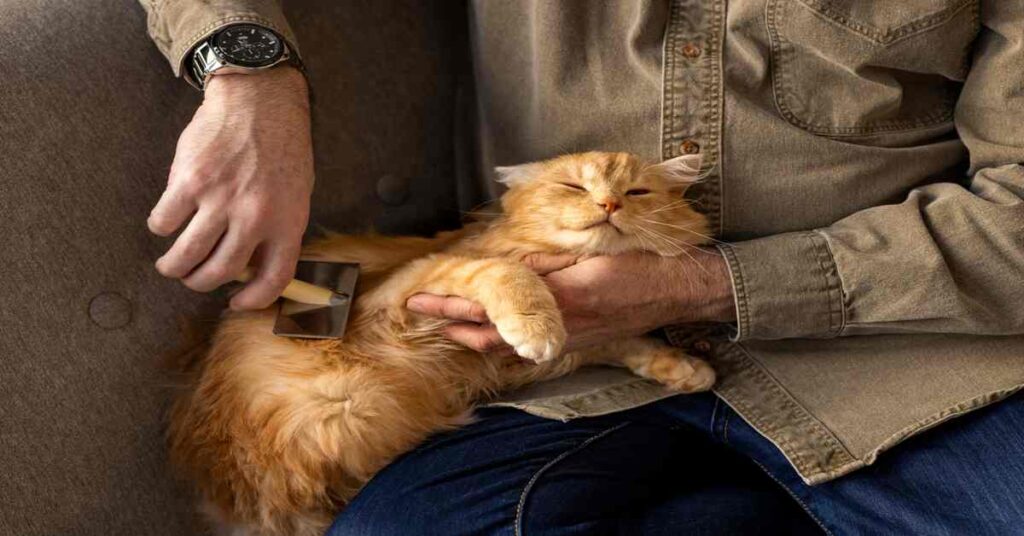How to pet a cat, Welcome to our short introduction to how to pet a cat! Petting a cat can be a wonderful experience when done correctly. Join us as we explore some simple tips and guidelines for interacting with our feline friends in a way they’ll appreciate and enjoy.
How to pet a cat, many cats enjoy being touched, but it depends on the individual cat and their preferences. Some cats may love being petted and seek out affection from their owners, while others may be more selective or prefer limited physical contact. It’s essential to pay attention to your cat’s body language and cues to determine if they enjoy being touched and to respect their boundaries.
How to Pet a Cat?

New cat caring
Taking care of a new cat involves several key steps to ensure their health and well-being:
- Set up a Safe Space: Create a comfortable and secure area for your new cat to explore and relax in, such as a quiet room with a cozy bed, food and water bowls, litter box, scratching post, and toys.
- Veterinary Care: Schedule a veterinary check-up for your new cat to ensure they are healthy and up-to-date on vaccinations. Discuss preventive care, such as parasite control and spaying/neutering, with your veterinarian.
- Nutrition: Provide a balanced diet formulated specifically for cats. Choose high-quality cat food and follow feeding guidelines based on your cat’s age, weight, and activity level. Fresh water should always be available.
- Socialization: Spend time bonding with your new cat through gentle interactions, such as petting, playing, and talking to them. Allow your cat to explore their new environment at their own pace and provide plenty of positive reinforcement.
- Grooming: Brush your cat regularly to remove loose fur and prevent matting. Trim their nails as needed and clean their ears and teeth to maintain their overall hygiene.
- Environmental Enrichment: Offer toys, scratching posts, and interactive play to keep your cat mentally and physically stimulated. Additionally, provides opportunities for climbing, hiding, and exploring to satisfy their natural instincts.
- Litter Box Training:
Show your new cat the location of the litter box and encourage them to use it by placing them in the box after meals or naps. Additionally, keep the litter box clean and easily accessible. - Monitoring Health: Watch for any signs of illness or behavior changes in your new cat, such as decreased appetite, lethargy, or litter box accidents. Seek veterinary attention if you have any concerns about your cat’s health.
New cat petting
When petting a new cat, it’s essential to approach them calmly and gently. Here are some steps to follow:
- Allow the cat to approach you first, rather than reaching out to them.
- Extend your hand slowly for them to sniff, letting them initiate contact.
- Use a soft, slow touch when petting, starting with gentle strokes on the head or back.
- Pay attention to the cat’s body language – if they seem tense or uncomfortable, stop petting and give them space.
- Speak softly and soothingly to the cat while petting to help them feel at ease.
- Avoid sensitive areas like the belly or tail, especially initially.
- Offer treats or praise as positive reinforcement for calm behavior.
- Be patient and give the cat time to become accustomed to your touch. By approaching the cat with patience, respect, and gentleness, you can build trust and create a positive bonding experience for both of you.
How to Pet a Cat?
To pet a cat, follow these steps:
- Start by Approaching calmly and slowly.
- then Offer your hand for sniffing.
- Gently stroke their head or back.
- moreover Watch for signs of enjoyment, like purring or kneading.
- additionally, Avoid sensitive areas like the belly.
- Also, Respect their boundaries and stop if they show signs of discomfort.
- Let the cat come to you for petting.
- Provide treats or praise for positive interactions. By following these steps, you can ensure a positive and enjoyable experience for both you and the cat.
How to Pet a Cat – Presenting yourself
When presenting yourself to your cat, it’s important to approach them calmly and respectfully. Here’s how to do it:
- Approach slowly and quietly, avoiding sudden movements or loud noises.
- Get down to the cat’s level by kneeling or sitting on the floor to appear less intimidating.
- Extend your hand towards the cat, palm down, to allow them to sniff you. Moreover, approach slowly and avoid sudden movements to avoid startling them.
- Avoid making direct eye contact, as this can be perceived as threatening in cat language.
- Speak softly and soothingly to the cat to reassure them.
- Allow the cat to approach you on their terms and show interest in interacting.
- Offer gentle petting or scratches on the head or chin if the cat seems receptive.
- Respect the cat’s boundaries and cues, and back off if they show signs of discomfort or agitation. Moreover, by presenting yourself to your cat in a calm and non-threatening manner, you can help build trust and strengthen your bond with them over time.
Where should I pet my cat?
You can pet your cat in various areas where they enjoy being touched. Some common spots include:
- Head: Many cats enjoy gentle strokes on the top of their head or behind their ears.
- Chin and Cheeks: Lightly scratching or rubbing under the chin or along the cheeks can be very pleasing for cats.
- Back: Stroke your cat’s back from the base of their neck to the base of their tail, following the direction of their fur.
- Shoulders: Gently petting or massaging the area between the shoulder blades can feel relaxing for some cats.
- Base of the Tail: Some cats enjoy being petted at the base of their tail, but be cautious as this area can be sensitive for others.
- Belly (with caution): While some cats enjoy belly rubs, others may not. Approach this area cautiously and stop if your cat shows signs of discomfort.
Read more about cat’s facts

Petting your cat is a delightful way to bond. Start by approaching calmly and offering your hand for them to sniff. Additionally, be gentle and respectful of their boundaries. Use slow, calming strokes, and watch their body language for cues. Finally, enjoy the purrs and affection that follow!
How to Pet a Cat FaQs
How does a cat like to be petted?
- Cats like gentle strokes and head rubs.
- Slow movements are best.
- Follow your cat’s lead.
- Respect their boundaries.
- Tail base petting varies.
- Observe their preferences.
- Adjust your technique accordingly.
How do you pet a cat without annoying it?
To pet a cat without annoying it, follow these tips:
- Approach calmly and quietly.
- Let the cat come to you.
- Offer your hand for sniffing.
- Start with gentle strokes on the head or back.
- Watch for signs of enjoyment.
- Avoid sensitive areas like the belly.
- Respect their boundaries and cues.
- Stop if the cat shows signs of discomfort.
- Keep the petting sessions short and positive. By following these guidelines, you can pet your cat in a way that they enjoy and avoid irritating them.
What not to do when petting a cat?
- Approach cats calmly to avoid startling them.
- Watch for warning signs like tail twitching.
- Pet in the direction of the fur.
- Avoid sensitive areas like the belly.
- Be gentle to avoid hurting them.
- Let cats come to you; don’t force them.
- Wash your hands before petting.
- Respect their personal space.
- Consider allergies when petting.
How do you get a cat to like you?
Building a bond with a cat takes time and patience. Here are some tips to help a cat warm up to you:
- Respect their space: Allow the cat to approach you on their terms and avoid forcing interactions.
- Use gentle movements: Approach the cat calmly and avoid sudden movements that may startle them.
- Offer treats and toys: Use positive reinforcement to associate your presence with good things like treats and playtime. Additionally, praise and reward your cat for positive behaviors to strengthen your bond.
- Provide comfortable surroundings: Create a safe and comfortable environment with cozy resting spots and hiding places.
- Spend quality time together: Spend time sitting quietly near the cat, reading or working, in order to help them become accustomed to your presence.
- Pet them gently: Once the cat seems comfortable, offer gentle pets and scratches in their favorite spots.
- Be patient: Building trust takes time, so be patient and allow the relationship to develop naturally.
Here is more about cat’s Petting




